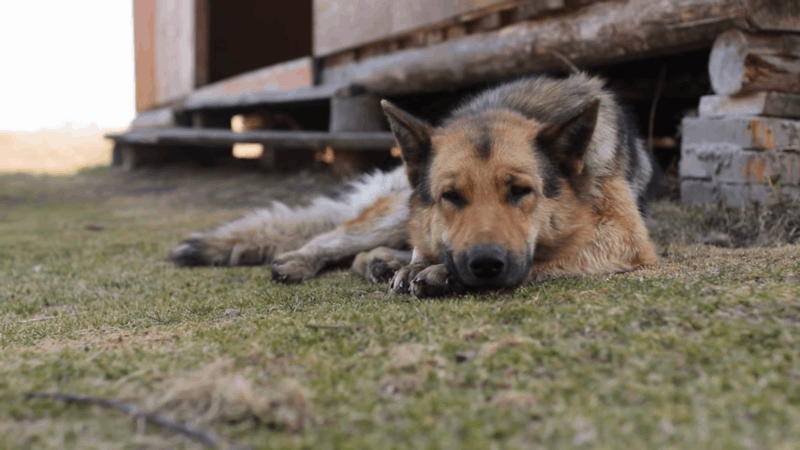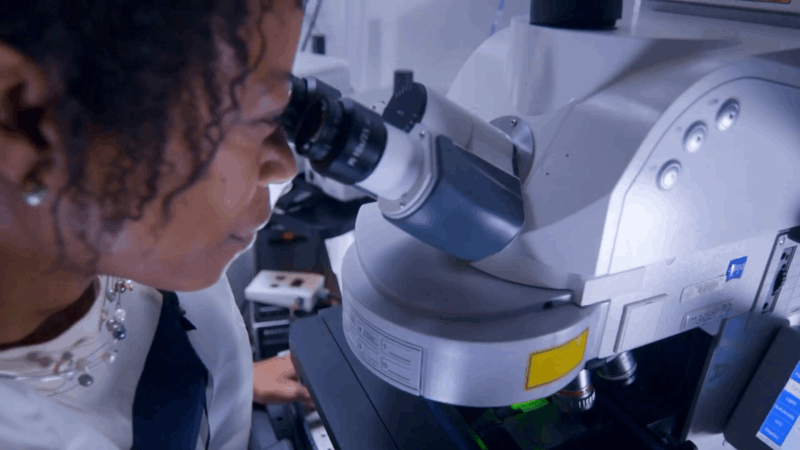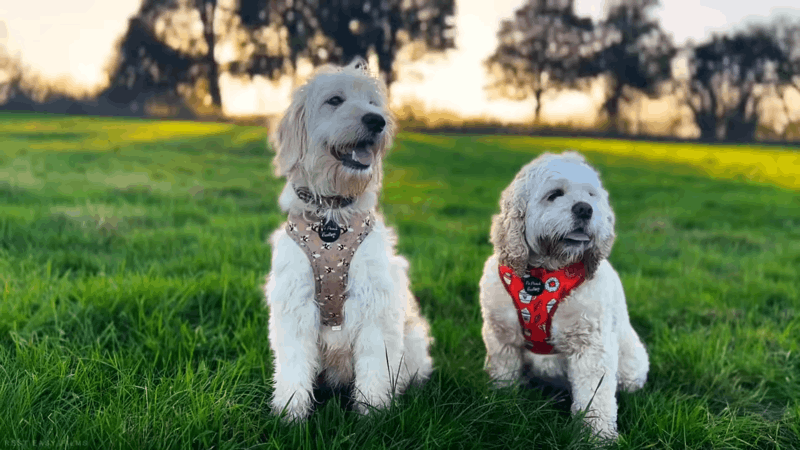No products in the cart.
Amidst the search for natural and effective solutions to alleviate furry friends’ discomfort, pet owners are turning to CBD oil dog hot spots, a remedy that is becoming increasingly popular.
This blog will discuss CBD for dogs, potential side effects, and crucial factors to take into account when selecting a CBD product for your dog. Discover how CBD oil might become a valuable addition to your pet’s wellness routine, offering them the relief they deserve from hot spots and supporting their overall health and happiness.
What is a Hot Spot on a Dog?

A hot spot on a dog, also known as acute moist dermatitis, is a localized area of skin inflammation and irritation. It appears as a red, moist, and often oozing sore, which can be painful and uncomfortable for the dog.
Hot spots typically develop quickly and can occur anywhere on the dog’s body. These areas are characterized by intense itching, leading the dog to scratch, lick, or bite at the affected area, further aggravating the condition. Timely attention and proper care are essential to treat and prevent hot spots from worsening or recurring.
What Causes Hot Spots on Dogs?
Hot spots on dogs can be caused by various factors. There are some common causes of hot spots that pet owners should consider
- Allergies: Due to allergies in dogs to specific things like pollen, food ingredients, fleas, or environmental irritants like dust or chemicals, dogs might develop hot spots.
- Skin irritation: Flea bites, tick infestations, matted hair, or skin illnesses are some of the reasons that can cause hot spots.
- Moisture and heat: Damp and warm conditions can create an ideal environment for bacterial growth, leading to hot spots. Dogs that have thick coats or spend a lot of time in humid environments are more prone to developing hot spots.
- Self-trauma: Dogs may scratch, lick, or bite their skin excessively due to boredom, anxiety, or skin discomfort, leading to the development of hot spots.
- Skin injuries: Cuts, abrasions, or insect bites are skin injuries that can become a hotspot if it gets infected or if the dog continuously irritates the area.
Identifying and addressing the underlying cause is crucial in effectively treating and preventing hot spots on dogs. Consulting a veterinarian is recommended for proper diagnosis and appropriate treatment.
What do Hot Spots Look Like on Dogs?
Hot spots on dogs have distinct visual characteristics. Here’s how they typically appear:
- Redness: Hot spots often have a noticeable red coloration on the skin. The affected area may appear inflamed and irritated.
- Moisture: Hot spots are commonly moist or oozing, thanks to the dog’s excessive scratching, licking, or biting at the area. The surrounding fur may appear damp or matted.
- Swelling: The skin around the hot spot may be slightly raised or swollen, indicating inflammation.
- Hair loss: Due to the dog’s continuous scratching or licking, hair loss can occur in and around the hot spot, making it more visible.
- Pain and discomfort: Dogs with hot spots may exhibit signs of discomfort, such as scratching or biting at the affected area, whimpering, or avoiding contact with the hotspot.
Hot spots can vary in size, ranging from small, coin-sized lesions to larger, more extensive areas of irritation. It’s important to note that these visual characteristics may also be indicative of other skin conditions, so proper diagnosis by a veterinarian is crucial for accurate identification and appropriate treatment.
Can Hot Spots Kill a Dog?
Hot spots themselves are generally not life-threatening to dogs. However, if they are not treated or the underlying cause is not addressed, hot spots can worsen and produce more significant issues.
The excessive scratching, licking, and biting associated with hot spots can cause skin infections, which may require medical intervention. In severe cases, untreated infections can spread, leading to systemic illness and potentially impacting the dog’s overall health. Additionally, hot spots can weaken the immune system if they develop into chronic conditions or if underlying health problems exist.
Hot spots may not directly kill a dog, however, it is important to address them promptly to prevent potential complications and ensure the well-being of your pet. Seeking veterinary care and following their guidance is essential for appropriate treatment and prevention of further complications.
How to Treat Hot Spots on Dogs?

Treating hot spots on dogs involves a comprehensive approach aimed at alleviating discomfort, promoting healing, and targeting the underlying cause. It is crucial to seek veterinary guidance for an accurate diagnosis and a personalized treatment plan that suits your dog’s specific needs. To ensure that your dog receives appropriate care, tailored interventions, and ongoing monitoring to facilitate a successful recovery, please consult with a veterinarian.
Natural Remedies for Hot Spots on Dogs
To help provide relief and aid in the healing process here are a few natural remedies for hot spots on dogs to consider
- Epsom salt soaks: Dissolve Epsom salt in warm water and gently soak the affected area for 5-10 minutes a few times a day. Epsom salt can help reduce inflammation and promote healing.
- Aloe vera: Apply pure aloe vera gel to the hot spot to soothe the skin and promote healing. Please make sure that the aloe vera used for dogs does not contain any added ingredients like alcohol or fragrances.
- Herbal infusions: Calendula, chamomile, or green tea can be brewed and cooled. Use a clean cloth soaked in the herbal infusion as a compress on the hot spot to help reduce inflammation and provide relief.
- Apple cider vinegar (ACV) Dilution: Mix equal parts of ACV and water, and gently dab the solution onto the hot spot with a clean cloth or cotton ball. Due to its antibacterial qualities, ACV can aid in eliminating any skin-related bacteria.
- Coconut oil: Virgin organic coconut oil should be applied in a thin layer to the hot location to hydrate the skin and encourage healing. In addition to having antibacterial qualities, coconut oil also helps prevent infections.
Remember to always monitor your dog’s reaction to any natural remedy and discontinue use if there are any adverse effects. It’s crucial to consult with a veterinarian for proper guidance, especially if the hot spot persists, worsens, or shows signs of infection.
Dog Hot Spot Healing Stages
The healing stages of a hot spot on a dog can vary depending on the severity of the condition and the effectiveness of the treatment. However, generally, hot spots go through the following healing stages
- Cleaning and treatment: The first step in healing a hot spot is to clean the affected area. This involves trimming the hair around the hotspot to prevent further irritation and to allow better airflow. To get rid of any dirt or bacteria, the region is then carefully washed with a mild antiseptic solution. This helps create an environment conducive to healing.
- Drying and protection: After cleaning, it is important to keep the hot spot dry. Drying the area can be achieved by gently patting it dry with a clean towel or using a pet-safe drying agent. To prevent further infection and promote healing, it is advised to apply a protective barrier like a topical antibiotic or antiseptic cream.
- Resolution of symptoms: As the healing process progresses, the dog’s symptoms should start to improve. The redness and inflammation of the hot spot should gradually diminish. The dog may experience less itching and discomfort, leading to a reduction in scratching or licking behaviors.
- Skin regrowth: Once the hot spot has started to heal, new skin cells will begin to regenerate. The area may appear pink or have a scab-like covering as the skin continues to heal. With time, hair growth should also resume in the affected area.
- Complete healing: Given proper care and treatment, the hot spot should continue to heal until it is fully resolved. The time it takes for a hot spot to fully heal can vary depending on its size and intensity, but with the proper treatment, most hot spots heal in a couple of weeks.
During the healing process, it’s important to monitor the hot spot closely and follow any instructions provided by a veterinarian. It is advised to seek veterinary care for additional assessment and treatment if the hot spot gets worse, doesn’t get better, or exhibits signs of infection.
CBD Oil Dog Hot Spots: Is It Safe and Effective?

CBD oil has gained popularity as a potential natural remedy for various ailments in both humans and pets. When it comes to hot spots on dogs, some pet owners may wonder if CBD oil is safe and effective. CBD oil may help alleviate inflammation, itching, and discomfort associated with hot spots. It’s crucial to remember that CBD oil dog hot spots must be utilized with a veterinarian’s supervision. Dosage, quality, and the specific needs of your dog should be considered.
Make sure the CBD oil dog hot spots is produced using high-quality processes and is free of dangerous ingredients. Consulting with a veterinarian can help determine if CBD oil is a suitable option for your dog’s hot spots and provide appropriate guidance for safe and effective use.
Combining CBD with Other Therapies: Enhancing Hot Spot Healing in Dogs
Combining CBD oil with other therapies can potentially enhance hot spot healing in dogs. While CBD oil dog hot spots may offer anti-inflammatory and soothing effects, it can be beneficial to incorporate additional approaches to address the underlying causes and promote healing. Here are some ways to combine CBD with other therapies:
- Veterinary guidance: Identify the root cause of the hot spots and create a thorough treatment plan with the help of a veterinarian. They can recommend appropriate medications, topical treatments, or dietary changes.
- Proper wound care: Clean the hot spots with a mild antiseptic solution recommended by your veterinarian and keep the area clean and dry. This helps prevent infection and promotes healing.
- Allergy management: If allergies contribute to hot spot development, work with your veterinarian to identify and manage allergens. This may involve dietary changes, hypoallergenic grooming products, or allergy testing.
- Nutritional support: Provide a balanced and nutritious diet to support overall skin health. The condition of the skin can be improved and inflammation reduced with the use of supplements like omega-3 fatty acids.
- Environmental modifications: If environmental factors exacerbate hot spots, make appropriate changes. For example, removing potential allergens, using hypoallergenic bedding, or keeping the dog’s living space clean and free from irritants.
- Behavioral modifications: Address underlying behavioral issues, such as anxiety or boredom, that may contribute to excessive scratching or licking. Enrichment activities, training, or behavioral therapy may be helpful.
- Regular monitoring: Continuously observe the hot spots and monitor your dog’s progress. Adjust treatments as needed and communicate any changes or concerns to your veterinarian.
Remember, every dog is unique, and the combination of therapies should be tailored to their specific needs. Working closely with a veterinarian will ensure a comprehensive approach that maximizes the potential benefits of CBD oil and other therapies to enhance hot spot healing in dogs.
Risks of Using CBD Oil Dog Hot Spots
There are a few considerations and risks associated with CBD oil dog hot spots:
- Quality and purity: Ensure that you use high-quality CBD oil specifically formulated for pets. Look for products that are third-party tested to ensure potency, purity, and absence of contaminants.
- Drug interactions: CBD oil may interact with certain medications, such as those metabolized by the liver. To prevent any potential interactions, be sure to tell your vet about all of the drugs your dog is on.
- THC content: The psychoactive ingredient in cannabis, THC, can be dangerous to dogs when present in CBD oil. Ensure that the CBD oil you choose has minimal or no THC content to avoid intoxication or other adverse effects.
- Individual sensitivity: Dogs may have different reactions to CBD oil dog hot spots, and what works for one dog may not work the same for another. Start with a low dose and monitor your dog’s response carefully.
Before taking CBD oil dog hot spots or any other condition, it is advisable to speak with a veterinarian as you would with any new medication. They can offer advice based on the particular requirements, health conditions, and potential hazards or contraindications of your dog.
Conclusion
CBD oil dog hot spots offers a promising and natural solution for pet owners seeking to alleviate their furry companion’s discomfort. CBD oil dog hot spots offers an alternative to conventional medicines that can have unfavorable side effects because it is a non-psychoactive and secure solution. When implementing CBD oil into a dog’s care routine, it is essential to consult with a veterinarian to ensure proper dosage and safety.
Hello, I am Hazel Bennett, an experienced copywriter specializing in the fascinating topic of CBD for dogs. With a passion for pet wellness and extensive knowledge of CBD’s potential benefits, I am here to provide you with informative and engaging content.



